Abstract
1. The effects of tetanus toxin were determined on GABA-mediated synaptic inhibition of substantia nigra neurones evoked by striatal stimulation and on the presumed dopamine- and 5-hydroxytryptamine-mediated synaptic inhibition of striatal neurones evoked by nigral and dorsal raphe nucleus stimulation, respectively, in the urethane-anaesthetized rat. 2. Following an intranigral injection of tetanus toxin, striatal-evoked inhibition of substantia nigra neurones, which is sensitive to bicuculline, was rapidly abolished. This effect was not accompanied by any significant change in the responses of nigral neurones to ionophoretically administered GABA or other putative neurotransmitters and thus indicates a presynaptic site of action of the toxin. 3. The rate of onset of action of the toxin in the substantia nigra was extremely rapid (1-4 min) and appeared to be related to the rate of activation of the inhibitory pathway. 4. Injections into the substantia nigra of tetanus toxin neutralized with antitoxin had no significant effect on striatal-evoked inhibition in the substantia nigra. 5. Injections of tetanus toxin into the striatum failed to influence the inhibition of striatal neurones evoked by stimulation of the ipsilateral substantia nigra or the dorsal raphe nucleus, suggesting that tetanus toxin does not impair monoamine-mediated inhibition in the central nervous system. 6. Synaptic excitation which preceded substantia-nigra-evoked inhibition in striatal neurones and which occasionally preceded striatal-evoked inhibition in nigral neurones was also unaffected by tetanus toxin. 7. It is suggested that tetanus toxin selectively abolishes GABA-mediated synaptic inhibition in the central nervous system and may be a useful tool in the identification of such synaptic inhibitory mechanisms.
Full text
PDF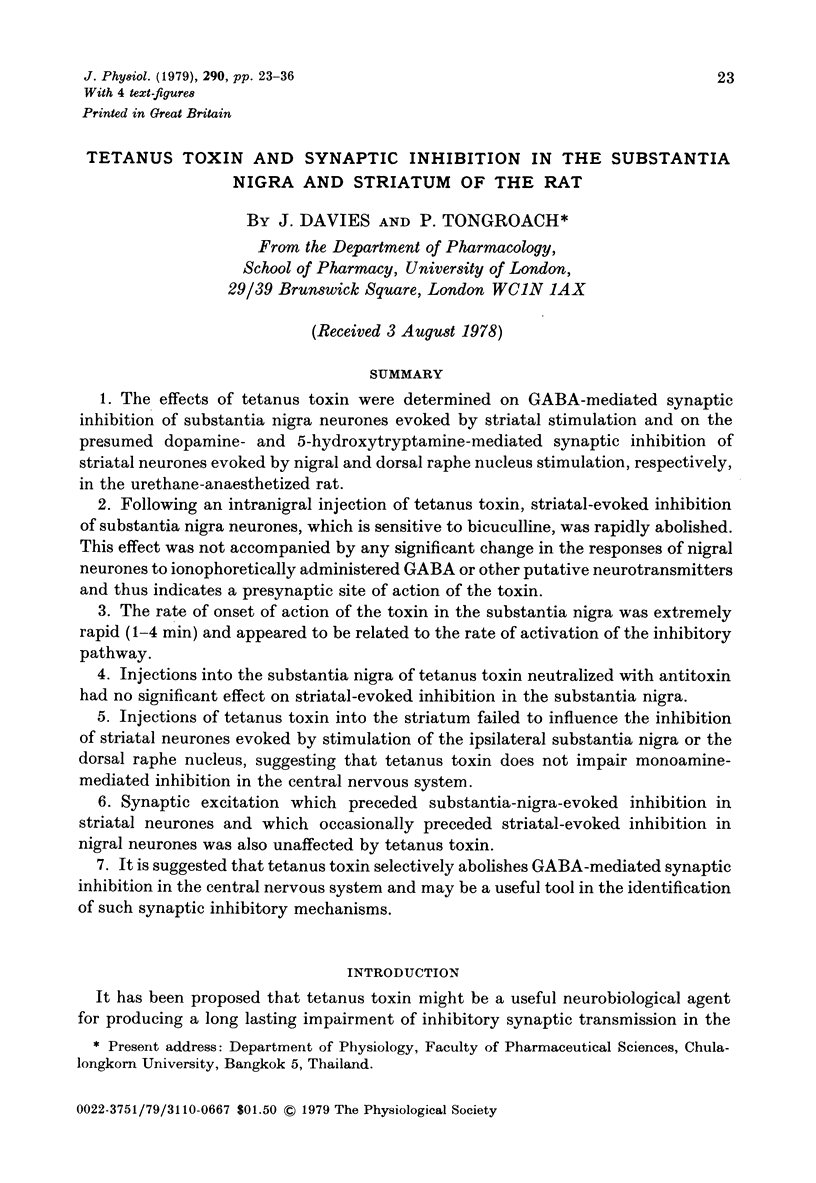
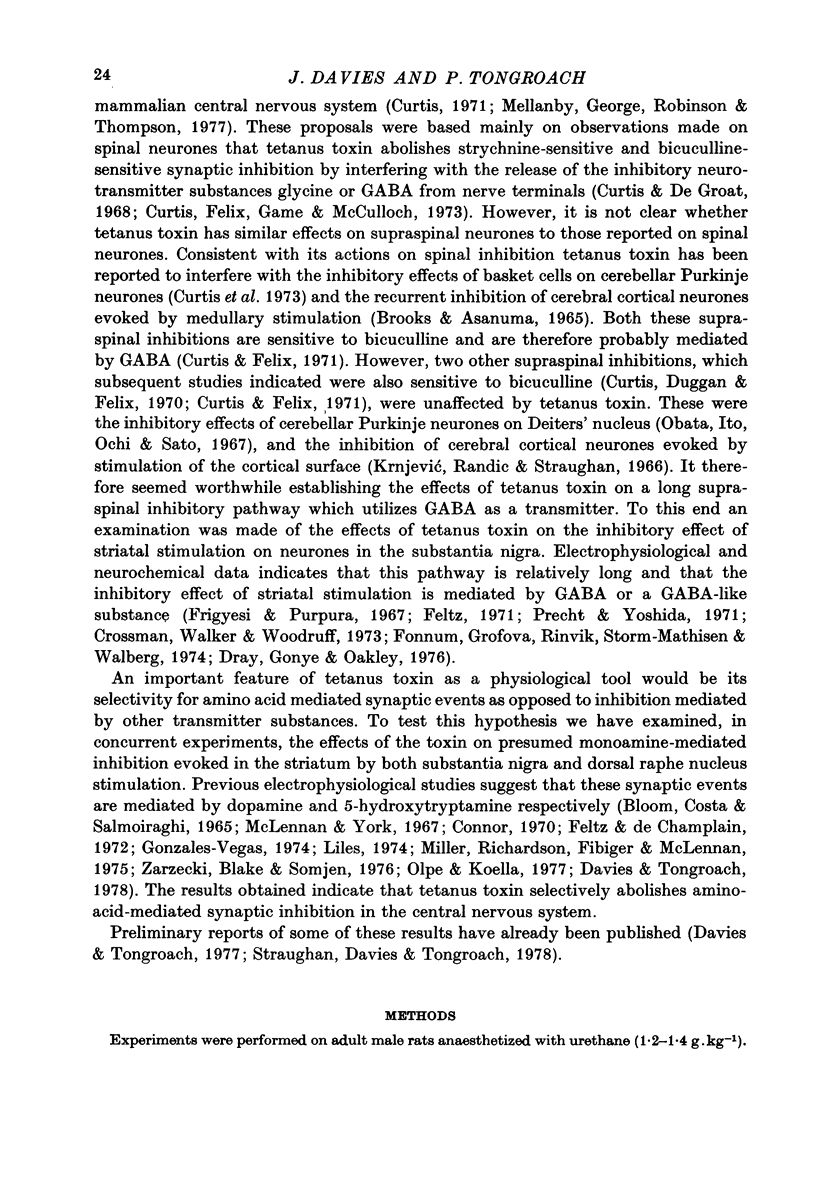
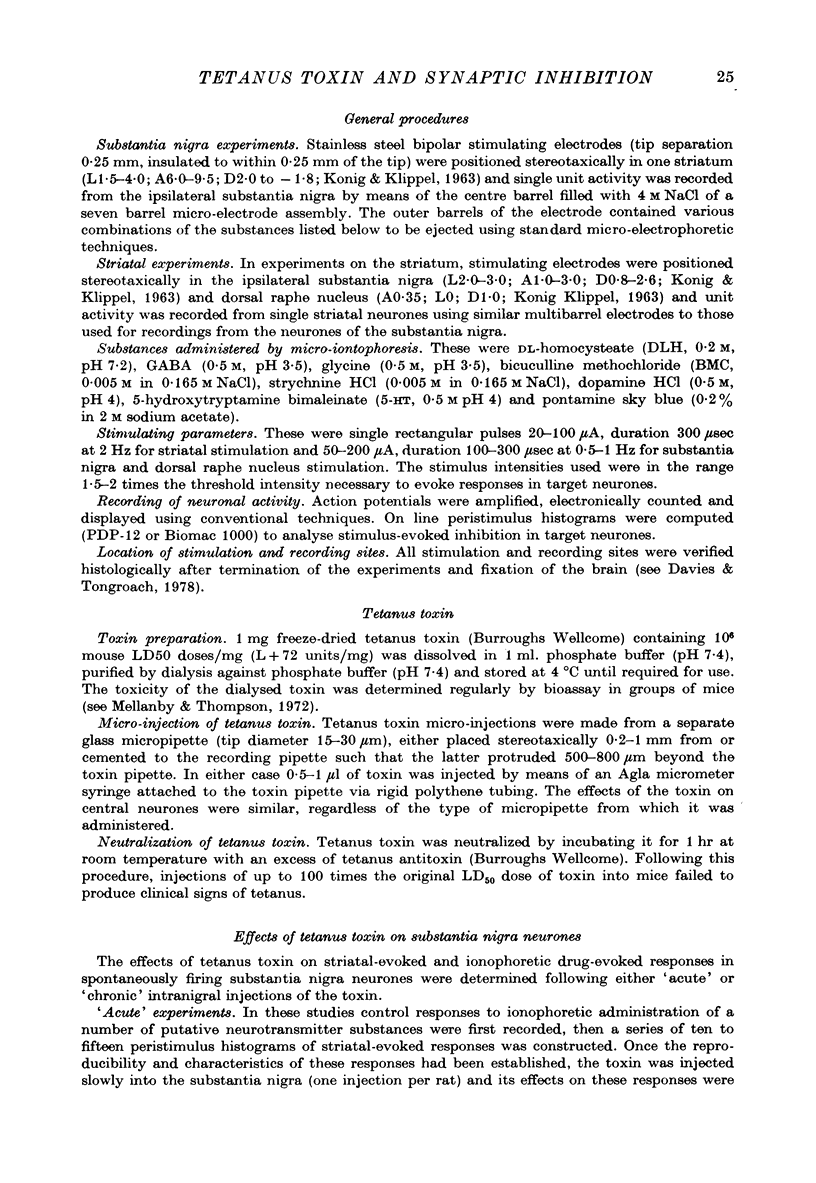
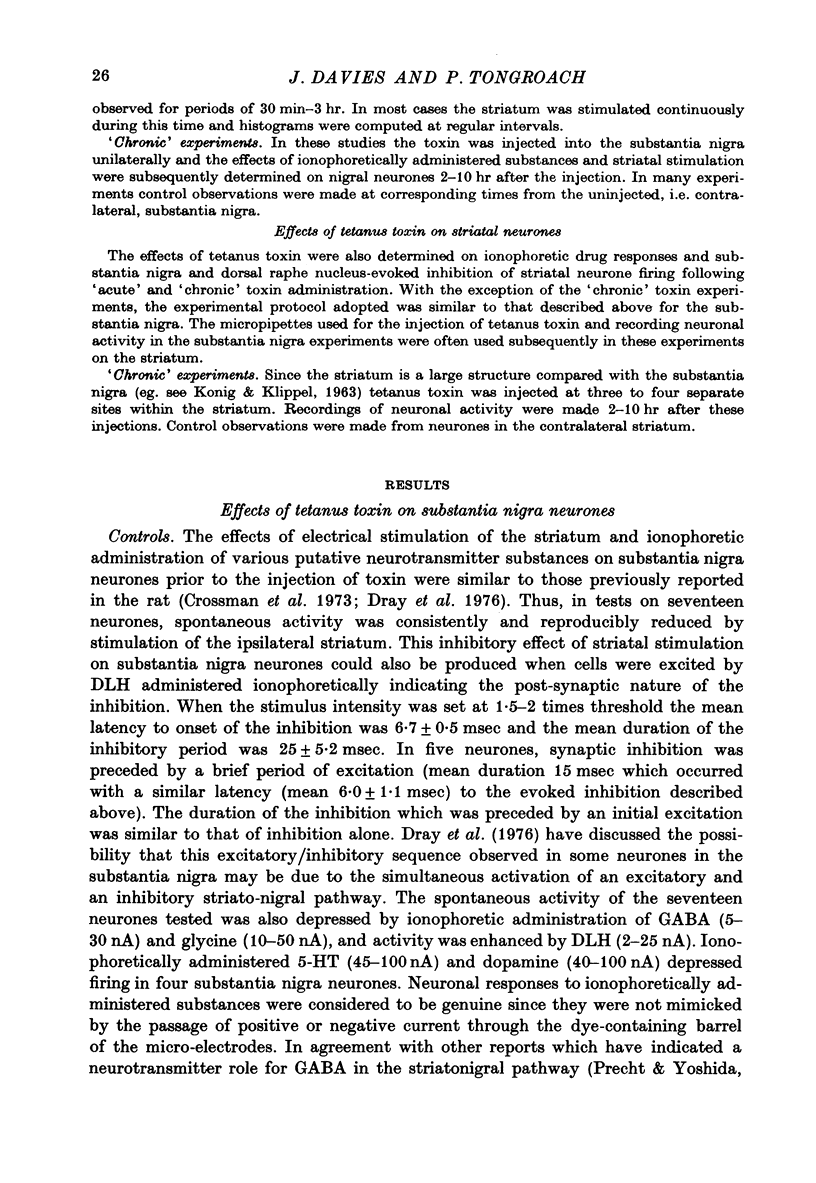
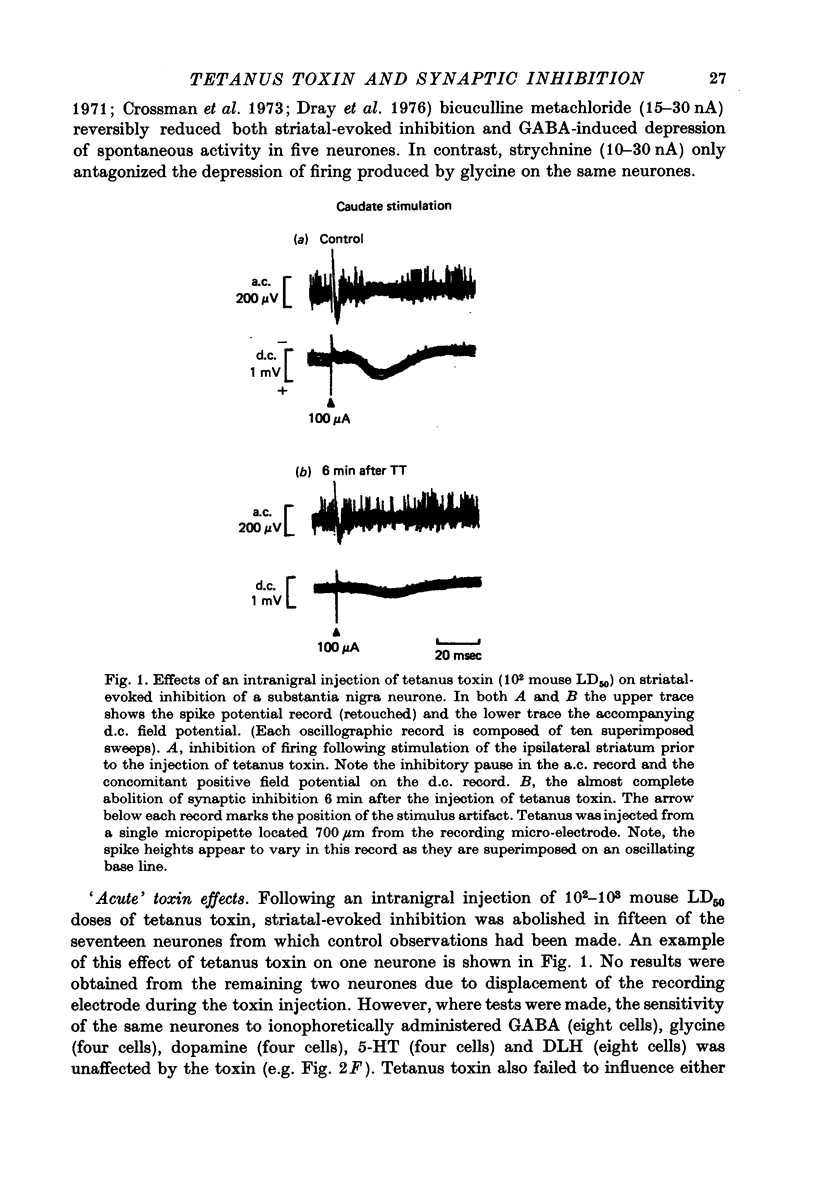
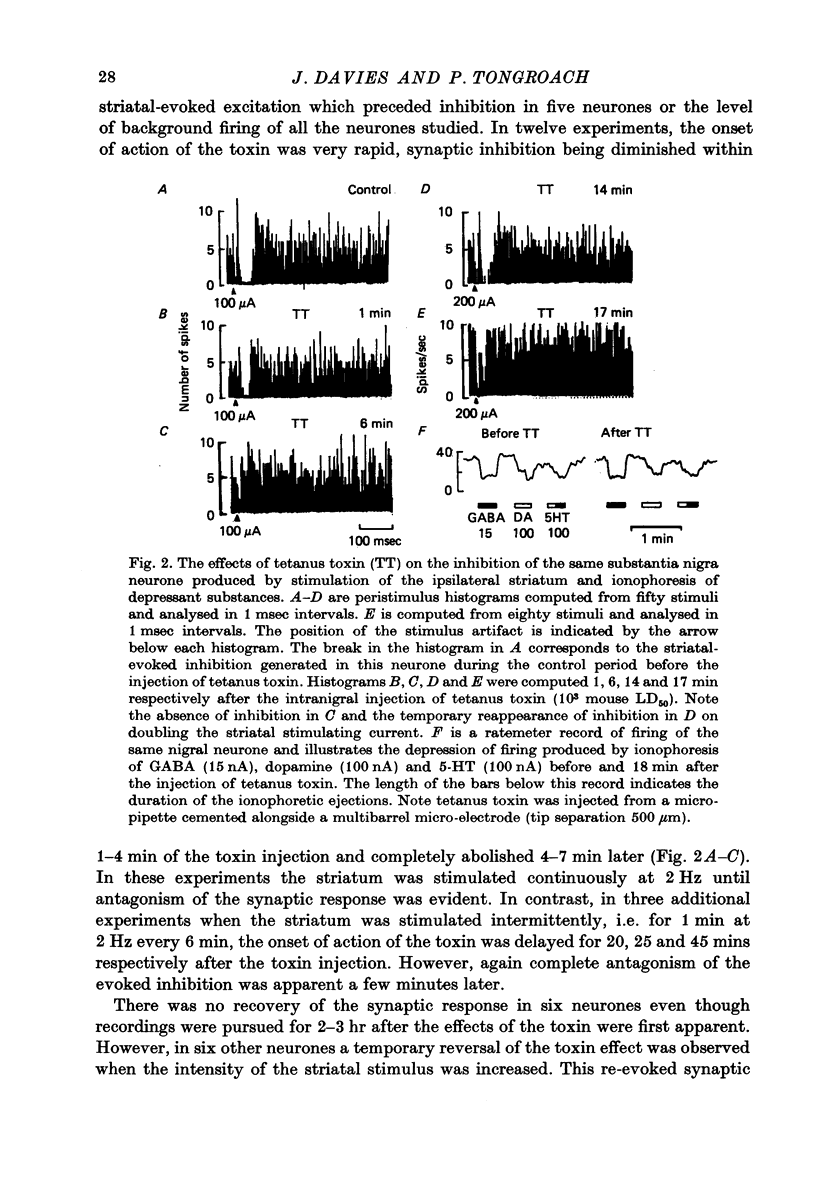
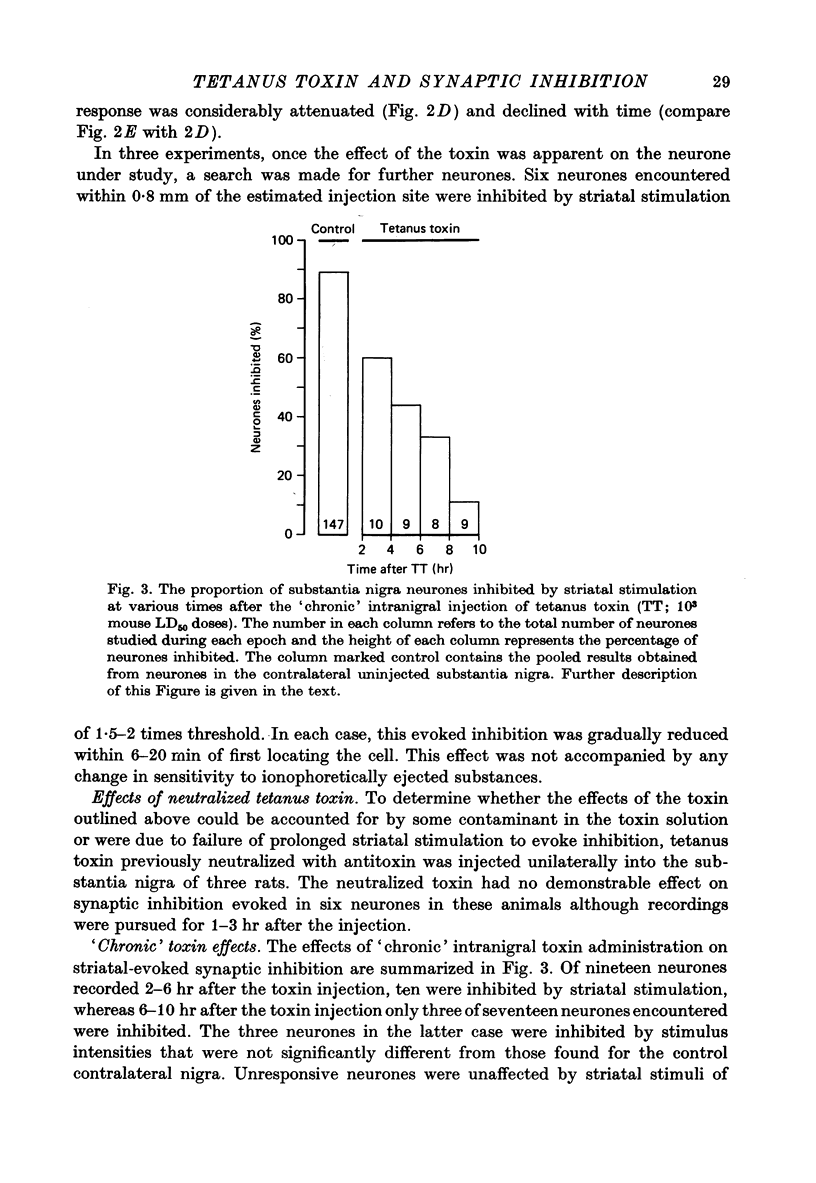
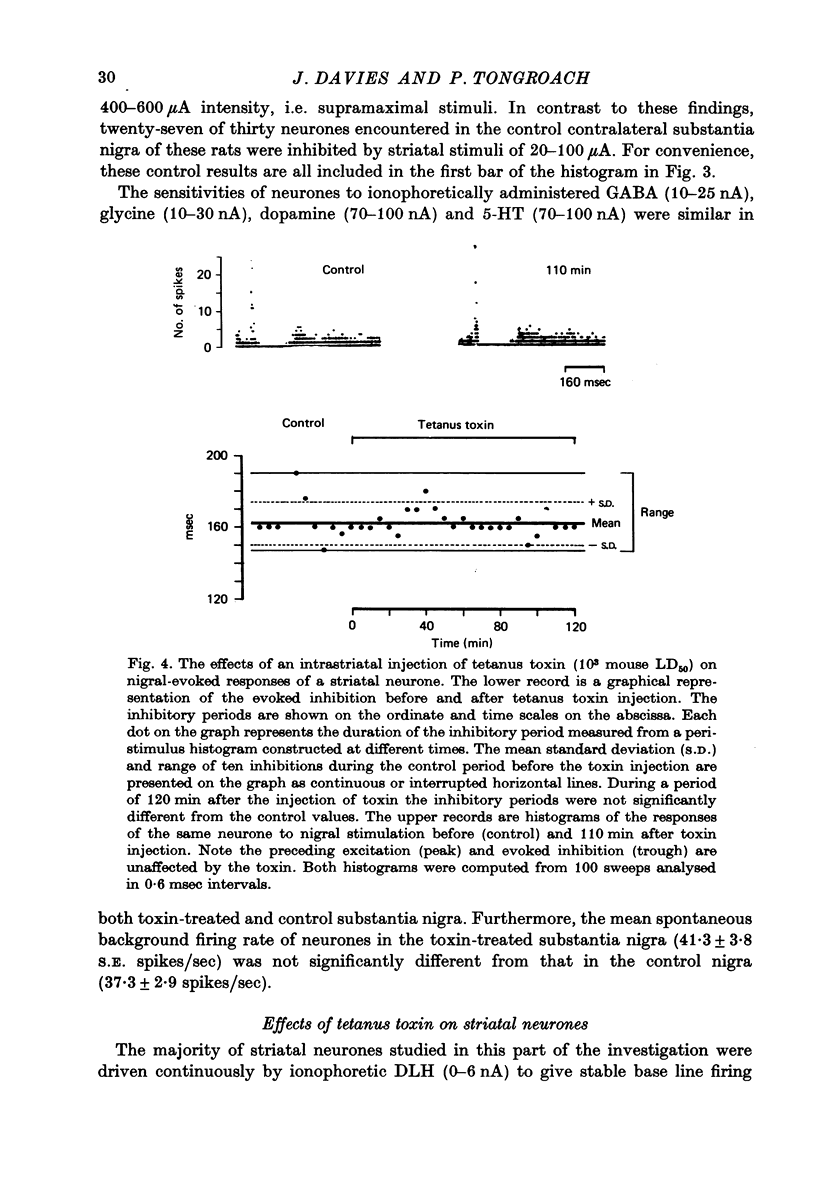
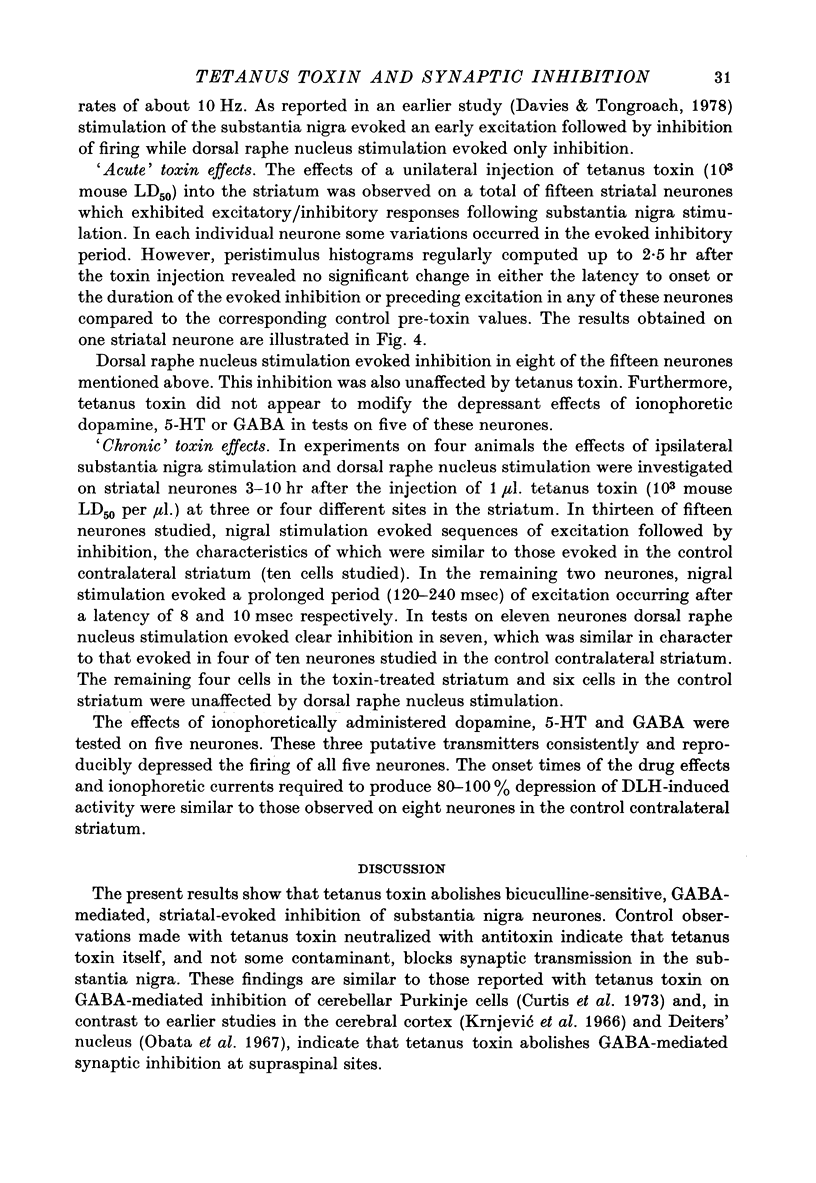

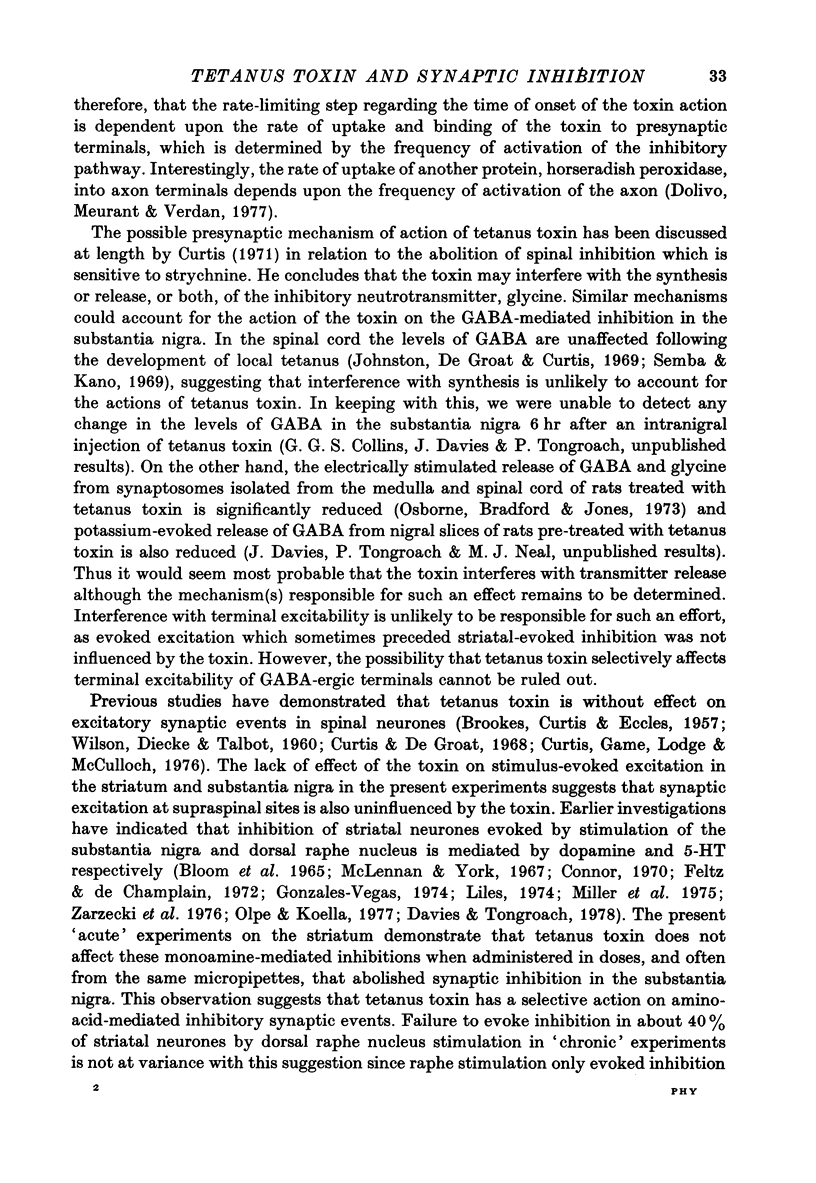
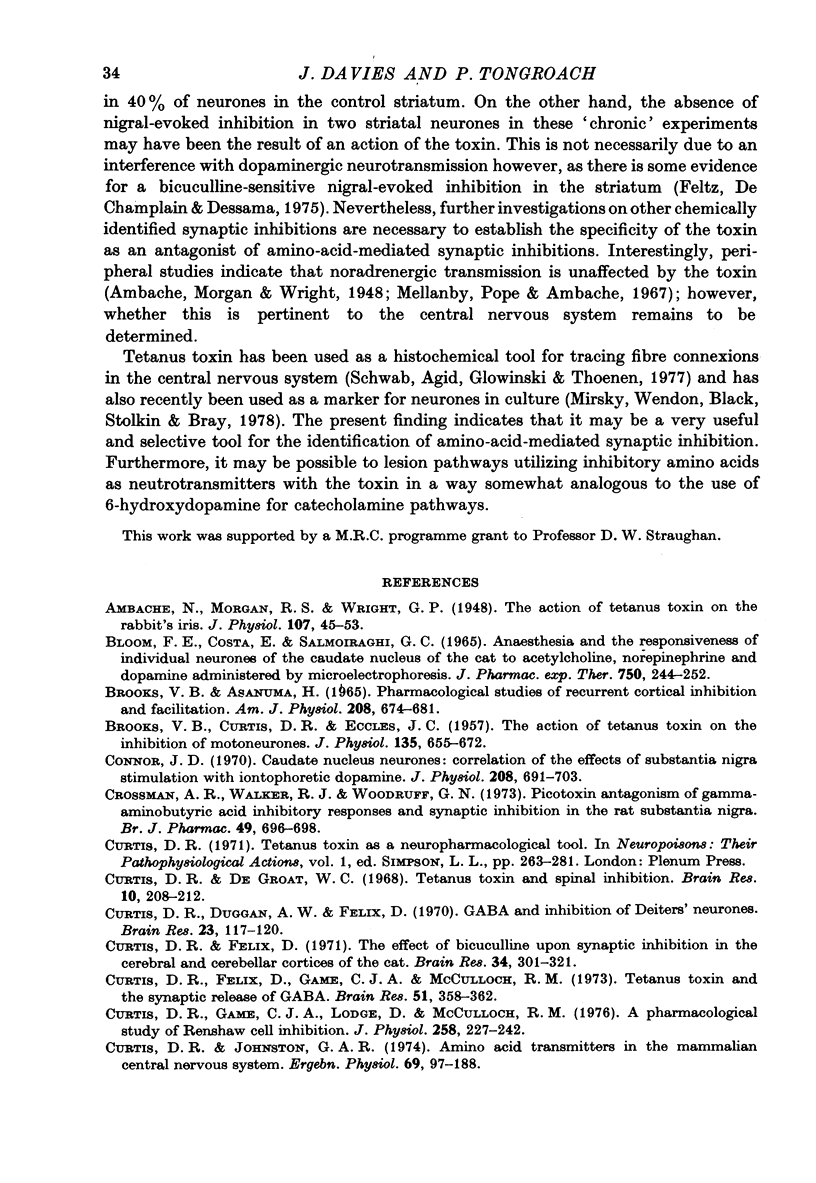
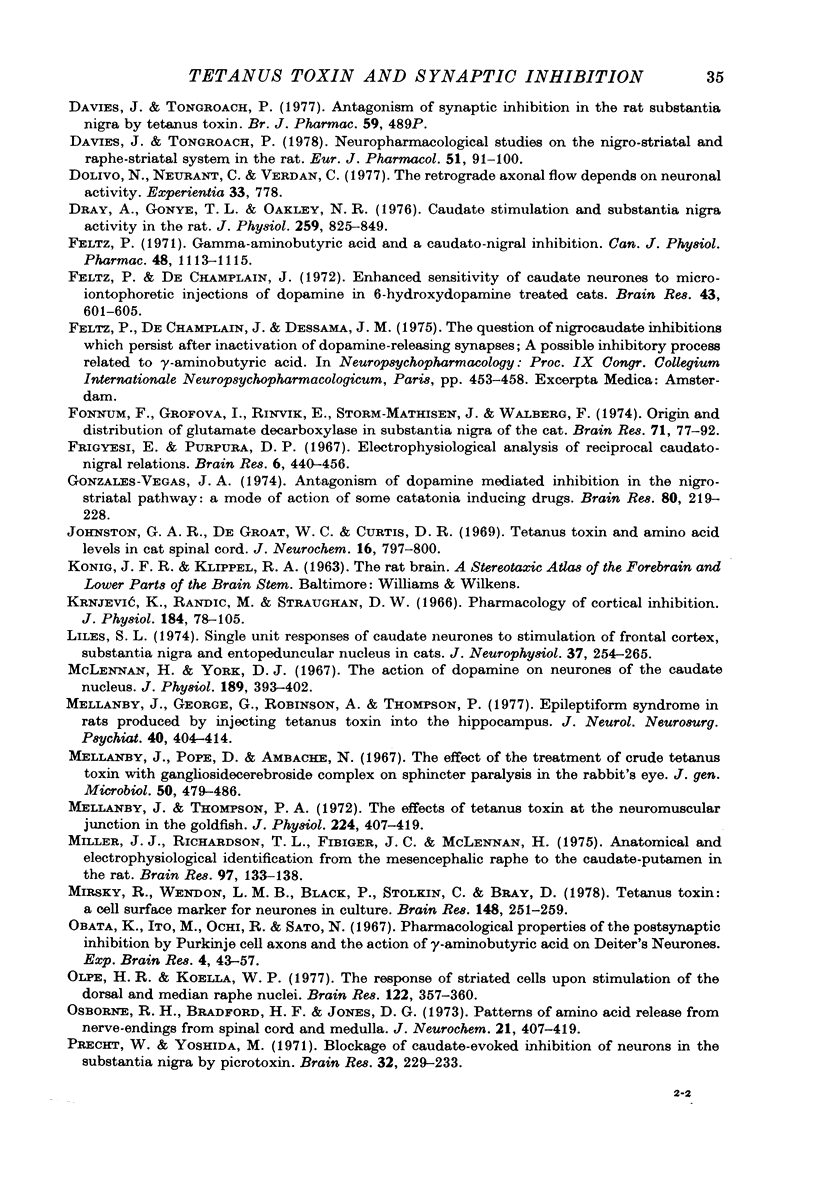
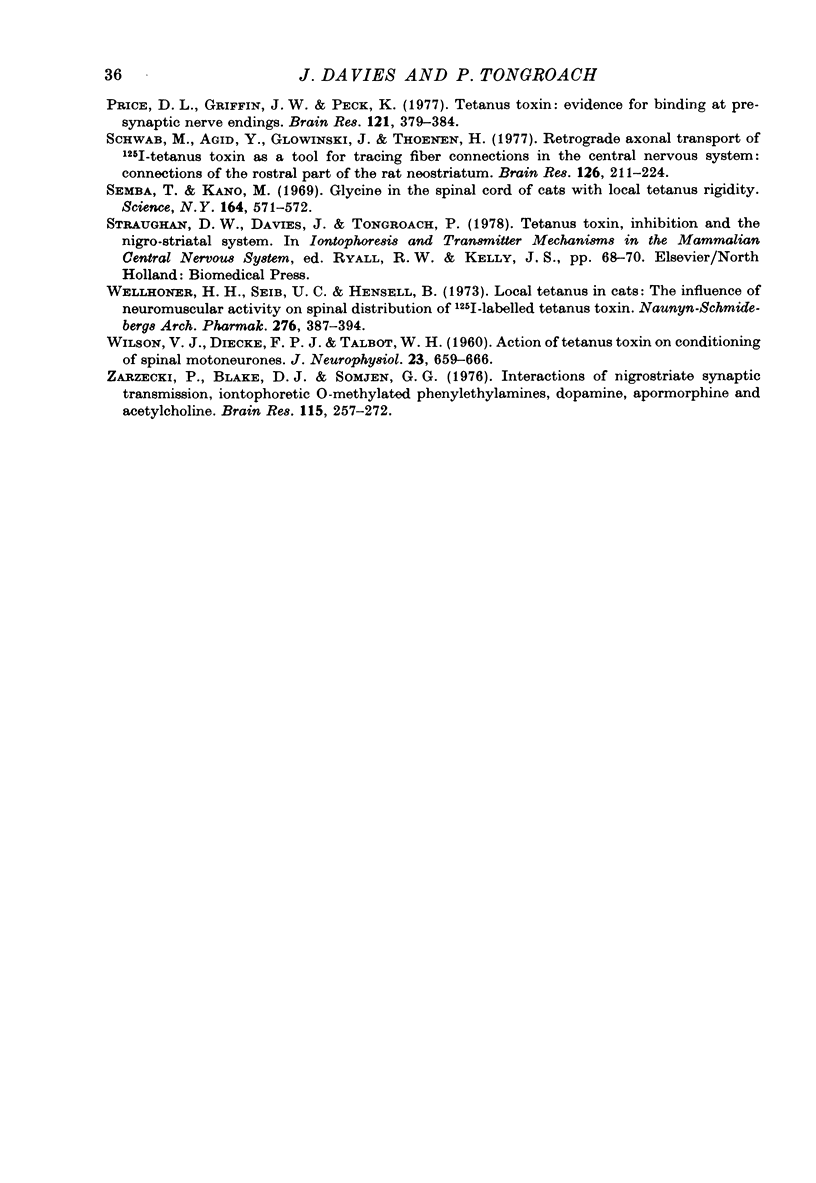
Selected References
These references are in PubMed. This may not be the complete list of references from this article.
- Ambache N., Morgan R. S., Wright G. P. The action of tetanus toxin on the rabbit's iris. J Physiol. 1948 Jan 1;107(1):45–53. doi: 10.1113/jphysiol.1948.sp004248. [DOI] [PMC free article] [PubMed] [Google Scholar]
- BROOKS V. B., CURTIS D. R., ECCLES J. C. The action of tetanus toxin on the inhibition of motoneurones. J Physiol. 1957 Mar 11;135(3):655–672. doi: 10.1113/jphysiol.1957.sp005737. [DOI] [PMC free article] [PubMed] [Google Scholar]
- Bloom F. E., Costa E., Salmoiraghi G. C. Anesthesia and the responsiveness of individual neurons of the caudate nucleus of the cat to acetylcholine, norepinephrine and dopamine administered by microelectrophoresis. J Pharmacol Exp Ther. 1965 Nov;150(2):244–252. [PubMed] [Google Scholar]
- Connor J. D. Caudate nucleus neurones: correlation of the effects of substantia nigra stimulaton with iontophoretic dopamine. J Physiol. 1970 Jul;208(3):691–703. doi: 10.1113/jphysiol.1970.sp009143. [DOI] [PMC free article] [PubMed] [Google Scholar]
- Crossman A. R., Walker R. J., Woodruff G. N. Picrotoxin antagonism of gamma-aminobutyric acid inhibitory responses and synaptic inhibition in the rat substantia nigra. Br J Pharmacol. 1973 Dec;49(4):696–698. doi: 10.1111/j.1476-5381.1973.tb08546.x. [DOI] [PMC free article] [PubMed] [Google Scholar]
- Curtis D. R., De Groat W. C. Tetanus toxin and spinal inhibition. Brain Res. 1968 Aug 26;10(2):208–212. doi: 10.1016/0006-8993(68)90123-6. [DOI] [PubMed] [Google Scholar]
- Curtis D. R., Duggan A. W., Felix D. GABA and inhibition of Deiters' neurones. Brain Res. 1970 Sep 29;23(1):117–120. doi: 10.1016/0006-8993(70)90357-4. [DOI] [PubMed] [Google Scholar]
- Curtis D. R., Felix D., Game C. J., McCulloch R. M. Tetanus toxin and the synaptic release of GABA. Brain Res. 1973 Mar 15;51:358–362. doi: 10.1016/0006-8993(73)90389-2. [DOI] [PubMed] [Google Scholar]
- Curtis D. R., Felix D. The effect of bicuculline upon synaptic inhibition in the cerebral and cerebellar corticles of the cat. Brain Res. 1971 Nov;34(2):301–321. doi: 10.1016/0006-8993(71)90283-6. [DOI] [PubMed] [Google Scholar]
- Curtis D. R., Game C. J., Lodge D., McCulloch R. M. A pharmacological study of Renshaw cell inhibition. J Physiol. 1976 Jun;258(1):227–242. doi: 10.1113/jphysiol.1976.sp011416. [DOI] [PMC free article] [PubMed] [Google Scholar]
- Curtis D. R., Johnston G. A. Amino acid transmitters in the mammalian central nervous system. Ergeb Physiol. 1974;69(0):97–188. doi: 10.1007/3-540-06498-2_3. [DOI] [PubMed] [Google Scholar]
- Davies J., Tongroach P. Antagonism of synaptic inhibition in the rat substantia nigra by tetanus toxin [proceedings]. Br J Pharmacol. 1977 Mar;59(3):489P–489P. [PMC free article] [PubMed] [Google Scholar]
- Davies J., Tongroach P. Neuropharmacological studies on the nigro-striatal and raphe-striatal system in the rat. Eur J Pharmacol. 1978 Sep 15;51(2):91–100. doi: 10.1016/0014-2999(78)90333-3. [DOI] [PubMed] [Google Scholar]
- Dray A., Gonye T. J., Oakley N. R. Caudate stimulation and substantia nigra activity in the rat. J Physiol. 1976 Aug;259(3):825–849. doi: 10.1113/jphysiol.1976.sp011497. [DOI] [PMC free article] [PubMed] [Google Scholar]
- Feltz P. -aminobutyric acid and a caudato-nigral inhibition. Can J Physiol Pharmacol. 1971 Dec;49(12):1113–1115. doi: 10.1139/y71-158. [DOI] [PubMed] [Google Scholar]
- Feltz P., De Champlain J. Enhanced sensitivity of caudate neurones to microiontophoretic injections of dopamine in 6-hydroxydopamine treated cats. Brain Res. 1972 Aug 25;43(2):601–605. doi: 10.1016/0006-8993(72)90414-3. [DOI] [PubMed] [Google Scholar]
- Fonnum F., Grofová I., Rinvik E., Storm-Mathisen J., Walberg F. Origin and distribution of glutamate decarboxylase in substantia nigra of the cat. Brain Res. 1974 May 10;71(1):77–92. doi: 10.1016/0006-8993(74)90192-9. [DOI] [PubMed] [Google Scholar]
- Frigyesi T. L., Purpura D. P. Electrophysiological analysis of reciprocal caudato-nigral relations. Brain Res. 1967 Nov;6(3):440–456. doi: 10.1016/0006-8993(67)90057-1. [DOI] [PubMed] [Google Scholar]
- Gonzalez-Vegas J. A. Antagonism of dopamine-mediated inhibition in the nigro-striatal pathway: a mode of action of some catatonia-inducing drugs. Brain Res. 1974 Nov 15;80(2):219–228. doi: 10.1016/0006-8993(74)90686-6. [DOI] [PubMed] [Google Scholar]
- Johnston G. A., De Groat W. C., Curtis D. R. Tetanus toxin and amino acid levels in cat spinal cord. J Neurochem. 1969 May;16(5):797–800. doi: 10.1111/j.1471-4159.1969.tb06459.x. [DOI] [PubMed] [Google Scholar]
- Krnjević K., Randić M., Straughan D. W. Pharmacology of cortical inhibition. J Physiol. 1966 May;184(1):78–105. doi: 10.1113/jphysiol.1966.sp007904. [DOI] [PMC free article] [PubMed] [Google Scholar]
- Liles S. L. Single-unit responses of caudate neurons to stimulation of frontal cortex, substantia nigra and entopeduncular nucleus in cats. J Neurophysiol. 1974 Jan;37(1):254–265. doi: 10.1152/jn.1974.37.1.254. [DOI] [PubMed] [Google Scholar]
- McLennan H., York D. H. The action of dopamine on neurones of the caudate nucleus. J Physiol. 1967 Apr;189(3):393–402. doi: 10.1113/jphysiol.1967.sp008175. [DOI] [PMC free article] [PubMed] [Google Scholar]
- Mellanby J., George G., Robinson A., Thompson P. Epileptiform syndrome in rats produced by injecting tetanus toxin into the hippocampus. J Neurol Neurosurg Psychiatry. 1977 Apr;40(4):404–414. doi: 10.1136/jnnp.40.4.404. [DOI] [PMC free article] [PubMed] [Google Scholar]
- Mellanby J., Pope D., Ambache N. The effect of the treatment of crude tetanus toxin with ganglioside cerebroside complex on sphincter paralysis in the rabbit's eye. J Gen Microbiol. 1968 Mar;50(3):479–486. doi: 10.1099/00221287-50-3-479. [DOI] [PubMed] [Google Scholar]
- Mellanby J., Thompson P. A. The effect of tetanus toxin at the neuromuscular junction in the goldfish. J Physiol. 1972 Jul;224(2):407–419. doi: 10.1113/jphysiol.1972.sp009902. [DOI] [PMC free article] [PubMed] [Google Scholar]
- Miller J. J., Richardson T. L., Fibiger H. C., McLennan H. Anatomical and electrophysiological identification of a projection from the mesencephalic raphe to the caudate-putamen in the rat. Brain Res. 1975 Oct 24;97(1):133–136. doi: 10.1016/0006-8993(75)90920-8. [DOI] [PubMed] [Google Scholar]
- Mirsky R., Wendon L. M., Black P., Stolkin C., Bray D. Tetanus toxin: a cell surface marker for neurones in culture. Brain Res. 1978 Jun 9;148(1):251–259. doi: 10.1016/0006-8993(78)90399-2. [DOI] [PubMed] [Google Scholar]
- Obata K., Ito M., Ochi R., Sato N. Pharmacological properties of the postsynaptic inhibition by Purkinje cell axons and the action of gamma-aminobutyric acid on deiters NEURONES. Exp Brain Res. 1967;4(1):43–57. doi: 10.1007/BF00235216. [DOI] [PubMed] [Google Scholar]
- Olpe H. R., Koella W. P. The response of striatal cells upon stimulation of the dorsal and median raphe nuclei. Brain Res. 1977 Feb 18;122(2):357–360. doi: 10.1016/0006-8993(77)90302-x. [DOI] [PubMed] [Google Scholar]
- Osborne R. H., Bradford H. F., Jones D. G. Patterns of amino acid release from nerve-endings isolated from spinal cord and medulla. J Neurochem. 1973 Aug;21(2):407–419. doi: 10.1111/j.1471-4159.1973.tb04260.x. [DOI] [PubMed] [Google Scholar]
- Precht W., Yoshida M. Blockage of caudate-evoked inhibition of neurons in the substantia nigra by picrotoxin. Brain Res. 1971 Sep 10;32(1):229–233. doi: 10.1016/0006-8993(71)90171-5. [DOI] [PubMed] [Google Scholar]
- Price D. L., Griffin J. W., Peck K. Tetanus toxin: evidence for binding at presynaptic nerve endings. Brain Res. 1977 Feb;121(2):379–384. doi: 10.1016/0006-8993(77)90163-9. [DOI] [PubMed] [Google Scholar]
- Schwab M., Agid Y., Glowinski J., Thoenen H. Retrograde axonal transport of 125I-tetanus toxin as a tool for tracing fiber connections in the central nervous system; connections of the rostral part of the rat neostriatum. Brain Res. 1977 May 6;126(2):211–224. doi: 10.1016/0006-8993(77)90722-3. [DOI] [PubMed] [Google Scholar]
- Semba T., Kano M. Glycine in the spinal cord of cats with local tetanus rigidity. Science. 1969 May 2;164(3879):571–572. doi: 10.1126/science.164.3879.571. [DOI] [PubMed] [Google Scholar]
- WILSON V. J., DIECKE F. P., TALBOT W. H. Action of tetanus toxin on conditioning of spinal motoneurons. J Neurophysiol. 1960 Nov;23:659–666. doi: 10.1152/jn.1960.23.6.659. [DOI] [PubMed] [Google Scholar]
- Wellhöner H. H., Seib U. C., Hensel B. Local tetanus in cats: the influence of neuromuscular activity on spinal distribution of 125 I labelled tetanus toxin. Naunyn Schmiedebergs Arch Pharmacol. 1973;276(3-4):387–394. doi: 10.1007/BF00499891. [DOI] [PubMed] [Google Scholar]
- Zarzecki P., Blake D. J., Somjen G. G. Interactions of nigrostriate synaptic transmission, iontophoretic O-methylated phenethylamines, dopamine, apomorphine and acetylcholine. Brain Res. 1976 Oct 15;115(2):257–272. doi: 10.1016/0006-8993(76)90511-4. [DOI] [PubMed] [Google Scholar]


